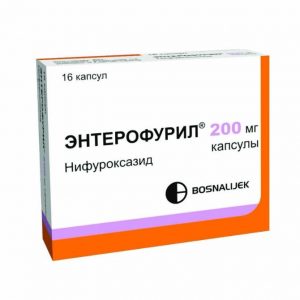Description
Release form
Tablets.
Packing
10 pcs
Pharmacological action
Combined antimicrobial.
Sulfamethoxazole, similar in structure to PABA, disrupts the synthesis of dihydrofolic acid in bacterial cells, preventing the inclusion of PABA in its molecule.
Trimethoprim enhances the action of sulfamethoxazole, disrupting the restoration of dihydrofolic acid into tetrahydrofolic acid, the active form of folic acid responsible for protein metabolism and microbial cell division.
In vitro is a broad-spectrum bactericidal drug, but sensitivity may depend on geographic location.
Usually sensitive pathogens (MPC less than 80 mg / L for sulfamethoxazole): Moraxella (Branhamella) catarrhalis. Haemophilus influenzae (beta-lactamase-forming and beta-lactamase-forming strains), Haemophilus parainfluenzae, Escherichia coli (including enterotoxigenic strains), Citrobacter spp. (including Citrobacter freundii), Klebsiella spp. (including Klebsiella pneumoniae, Klebsiella oxytoca), Enterobacter cloaceae, Enterobacter aerogenes, Hafnia alvei, Serratia spp. (including Serratia marcescens, Serratia liquefaciens), Proteus mirabilis, Proteus vulgaris, Morganella morganii, Shigella spp. (including Shigella flexneri, Shigella sonnei), Yersinia spp. (including Yersinia enterocolitica), Vibrio cholerae, Edwardsiella tarda, Alcaligenes faecalis, Burkholderia (Pseudomonas) cepacia, Burkholderia (Pseudomonas) pseudomallei.
Clinical experience shows that Brucella spp., Listeria monocytogenes, Nocardia asteroides, Pneumocystis carinii, Cyclospora cayetanensis can be sensitive.
Partially sensitive pathogens (MPC 80-160 mg / L for sulfamethoxazole): Staphylococcus spp. (coagulase-negative), including Staphylococcus aureus (methicillin-sensitive and methicillin-resistant strains), Streptococcus pneumoniae (penicillin-sensitive and penicillin-resistant strains), Haemophilus ducreyi, Providencia spp. (including Providencia rettgeri), Salmonella typhi, Salmonella enteritidis, Stenotrophomonas maltophilia (formerly called Xanthomonas maltophilia),
Acinetobacter lwoffii, Acinetobacter baumanii, Aeromonas hydrophila.
Resistant pathogens (MPC more than 160 mg / L for sulfamethoxazole): Mycoplasma spp., Mycobacterium tuberculosis, Treponema pallidum, Pseudomonas aeruginosa.
If the drug is prescribed empirically, it is necessary to take into account local characteristics of drug resistance of possible pathogens of a specific infectious disease.
For infections that may be caused by partially sensitive microorganisms, it is recommended that a sensitivity test be performed to rule out pathogen resistance.
Indications
Infections of the respiratory tract: chronic bronchitis (exacerbation) pneumocystis pneumonia (treatment and prevention) in adults and children
infections of the ENT organs: otitis media (in children)
infections of the genitourinary tract: urinary tract infections, mild chancre Typhoid fever, paratyphoid fever, shigellosis (caused by susceptible strains of Shigella flexneri and Shigella sonnei) travelers diarrhea caused by enterotoxic strains of Escherichia coli, cholera (in addition to supplementing fluid and electrolytes)
other bacterial projections (possible combination with antibiotics) nocardiosis, brucellosis (acute), actinomycosis, osteomyelitis (acute and chronic), South American blastomycosis, toxoplasmosis (as part of complex therapy).
Contraindications
Hypersensitivity (including to sulfonamides), hepatic and / or renal failure (CC less than 15 ml / min), aplastic anemia, B12-deficient anemia, agranulocytosis, leukopenia, glucose-6-glucose-6-deficiency periodogens lactation, childhood (for oral administration – up to 2 months or up to 6 weeks at birth from mothers with HIV infection, for intramuscular administration – up to 6 years), simultaneous administration with dofetilide.
Caution. Thyroid dysfunction, severe allergic reactions in history, bronchial asthma, folic acid deficiency, porphyria, pregnancy.
Use during pregnancy and lactation
The use of Co-trimoxazole during pregnancy is contraindicated. Lactating women should stop breastfeeding.
Composition
Active ingredient: 400 mg sulfamethoxazole, 80 mg trimethoprim.
Dosage and administration
Assign inside. Adults and children over 12 years of age are usually given 2 tablets (for adults) 2 times a day (morning and evening after eating) in severe cases, 3 tablets are prescribed 2 times a day for chronic infections – 1 tablet 2 times a day. Children from 2 to 5 years are usually prescribed for? tablets 2 times a day, from 5 to 12 years – 1 tablet 2 times a day.
The course of treatment lasts from 5 to 12-14 days, and in chronic infections it is longer and depends on the course of the disease.
Side effects of the
Digestive system: nausea, vomiting, diarrhea, glossitis, diarrhea, abdominal pain, lack of appetite, false diphtheria inflammation of the intestines, increased levels of liver and creatinine enzymes in the blood serum, inflammation of the mouth, tongue inflammation, inflammation of the pancreas, cholestatic hepatitis.
Allergic reactions: allergic myocarditis, chills, drug fever, photosensitivity, anaphylactic symptoms, skin rash, Quincke’s edema, Stevens-Jones syndrome, Lyell syndrome,
From the hemopoiesis: leukopenia, neutropenia, thrombocytopenia, agranulocytosis, megaloblastic anemia.
From the urinary system: crystalluria, hematuria, interstitial nephritis.
Metabolism: hypokalemia, hyponatremia.
Nervous system: apathy, aseptic meningitis, motor coordination disorder, headache, depression, cramp, hallucinations, nervousness, tinnitus, inflammation of the spinal nerves.
Internal secretion organs: cross-allergy, hypoglycemia, increased pyuresis.
Musculoskeletal system: joint pain, muscle pain.
Respiratory: choking, coughing, lung infiltrates.
Other: weakness, tiredness, insomnia.
Drug Interaction
Interaction with Other Medicines
When co-trimoxazole is used with indirect anticoagulants, the effect of the latter is greatly enhanced due to the slower inactivation of the latter. as well as their release from plasma proteins.
When combined with some sulfonylureas derivatives, the hypoglycemic effect may be enhanced.
Concomitant use of co-trimoxazole and methotrexate may lead to increased toxicity of the latter (in particular, the appearance of pancytopenia).
Under the influence of butadion, indomethacin, naproxen, salicylates and some other NSAIDs, co-trimoxazole may be enhanced with the development of undesirable effects, since the release of the active substances from the association with blood proteins and their concentration.
The concomitant use of diuretics and co-trimoxazole increases the likelihood of the latter being caused by thrombocytopenia, especially in the elderly. In the case of co-trimoxazole chloride co-administration, the antimicrobial action is enhanced because chloride inhibits the formation of tetrahydrofolic acid, which is necessary for the synthesis of nucleic acids and proteins. In turn, sulfanilamides inhibit the formation of dihydrofolic acid, which is a precursor of tetrahydrofolic acid. This combination is widely used in the treatment of toxoplasmosis. The absorption of co-trimoxazole when co-administered with cholestyramine decreases as a result of the formation of insoluble complexes, which leads to a decrease in their concentration in the blood.
Overdose
Symptoms: anorexia, nausea, weakness, abdominal pain, headache, drowsiness, hematuria, crystalluria.
Treatment: heavy drinking, gastric lavage, correction of electrolyte disorders. If necessary, appoint hemodialysis.
Bone marrow suppression (pancytopenia) is characteristic of chronic overdose.
Treatment and prevention: folic acid (5 – 15 mg daily).
Storage conditions
List B. In a place protected from moisture and light at a temperature not exceeding +25 ° C.
Expiration
5 years.
Pharmacy terms of sale
Prescription
Dosage form
dosage form
tablets
Pharmstandart-Leksredstva, Russia




